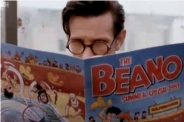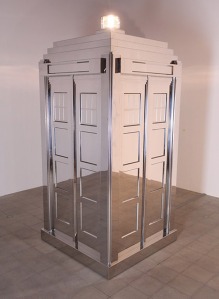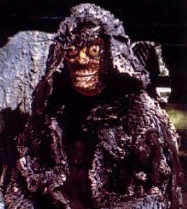 Doctor Who is not a television series or, at least, a single television series. This is an outrageous statement and is clearly debatable – in fact on the surface it’s clearly wrong. But I’m going to argue it anyway.
Doctor Who is not a television series or, at least, a single television series. This is an outrageous statement and is clearly debatable – in fact on the surface it’s clearly wrong. But I’m going to argue it anyway.
A short time ago I decided I’d give up and write the obvious article – what, in my opinion (IMHO for twitter users out there), is the greatest Doctor Who story ever made. So I sat down – I stood up – I paced for a while – I went to the toilet. I discovered to my astonishment that I didn’t know – I didn’t have an answer.
I decided the following: first that my favourite depended on my mood. When whimsical I like ‘Spearhead from Space’, when nostalgic I like ‘The Daemons’, when I’m in the mood to assess the quality of production (and possibly feeling slightly racist) I like ‘Talons of Weng Chiang’ when I’m going through one of my clinically depressed periods I like ‘Time Flight’ when I’m thirsty I like ‘Warriors of the Deep’. In fact I have a different favourite story for every mood: anger: ‘Deadly Assassin’, lust: ‘Planet of Fire’, asleep: ‘The Krotons’. The second thing I decided was more controversial – and that was that to compare ‘Blink’ with ‘The Aztecs’ or ‘Evil of the Daleks’ with ‘The Twin Dilemma’ or even ‘Horns of the Nimon’ with ’the Leisure Hive’ was pointless. The differences in style, cast, production team, format, narrative and visual sophistication or budget are such that the stories effectively exist in different television series. Doctor Who is not a television series – it is the umbrella title for a collection of television series, each with their own identity. So why is this thought so concerning to fans? Why is this idea likely to get me a kicking.
What I want to do in the following article is to highlight why fans (and the BBC) like the see Doctor Who as a creatively unbroken run – why it is so important in fandom to think of the Doctor played by William Hartnell to be the same character as the Doctor played by Matt Smith. I also want to pinpoint some of the moments throughout Doctor Who (which, paradoxically and slightly hypocritically, I’ll refer to as a ‘series’ as shorthand) in which the format ‘rebooted’. Some of these moments may be surprising…
So while I’m being lightly controversial I might as go the whole way and do a religious analogy. A fans relationship with Doctor Who (or any text) is a religious one. One part of being a fan means to know a lot about the production history of the text – to know who wrote, directed and produced what and what happened behind the scenes. Another part is a more creative aspect. A fan likes to fill the gaps between the stories – they like to resolve narrative continuity problems, to construct intricate histories of characters, monsters, planets. In this context, it’s important for a fan to think of Doctor Who as a coherent series – to believe that ‘The Daleks’ Masterplan’ takes place in the same ‘universe’ as ‘Victory of the Daleks’. A fan needs faith therefore: faith not in the knowledge, abilities or the integrity of the producers of the series but in the series itself. This is true across the board – think about Lost .Watching that first season, or even that first episode, viewer needed to have faith that the series had a direction, that J. J. Abrahms had a plan and was not just throwing narrative curveballs at the audience with the assumption that he could tidy it all up at a later date. With Doctor Who it’s more complicated.
So this faith is essential for a fan to be a fan – we need to have a single series to be a fan of – to dissect and analyse – we need to be able to connect ‘The Romans’ with ‘The Fires of Pompeii’. To do this, we need to believe that the series orbits fandom rather than the other way round. We’re naturally fearful of a Galilean scenario in which we discover that the series has been happily sitting in the middle whilst we orbit it. This is the reason many fans crave spoilers or are catty and aggressive on the web fora. We desire to be in control or to at least have access to those who are in control. This is easier with the new series as the show-runners have been time served fans themselves – we trust them to share our obsessions and quirks. But retrospectively considering the old series is more problematic. Verity Lambert was initially planning a matter of weeks in advance; Barry Letts didn’t look to Innes Lloyd’s version of the series every time he made a decision; Philip Hinchcliffe was actively trying to change the series to make his own mark. Only when John Nathan-Turner planned the twentieth anniversary season and discovered the commercial opportunities in fandom did the series begin to reference the past. In the context of the series itself, narrative continuity was born in 1983. Doctor Who is best defined as a text that slowly evolve but, in true X-Men style, occasionally leaps into a new phase of being.
So is it possible to identify some of these leaps? Let’s give it a go.
‘The Daleks’. It may seem odd to suggest that the second story saw a shift in the style of the series – but famously, the series as Sidney Newman (and a focus group lead panel of creative BBC types) devised it was primarily intended to use the science fiction format in an educative sense. ‘The Daleks’, ‘The Dead Planet’, ‘The Mutants’ or whatever you want to call the second story, saw Verity Lambert taking the series in a different, more commercial direction. ‘An Unearthly Child’ set the narrative template for Doctor Who, ‘The Daleks’ confirmed its potential for longevity and fixed the series in the popular imagination. It also acts visually and textually as a template for those first few years – the Hartnell stories recorded in tiny studios in Lime Grove took the audience to more alien planets and depicted more aliens than Russell T Davies ever did with his resources and budget, and ‘The Daleks’ demonstrated how this could be achieved.
‘The Tenth Planet’. This story ended with the dramatic change of the lead actor from Hartnell to Patrick Troughton, but it is really the narrative setup that suggests a shift in the format of the series. The ‘base-under-siege’ narrative has become something of a laudable cliché in fandom, but for the best part of two seasons it was the preferred type of story. ‘The Moonbase’, ‘Tomb of the Cyberman’, ‘The Abominable Snowmen’, ‘The Web of Fear’, ‘the Wheel in Space’ all feature variations or even simply rewrites of this formula. For a time in the late 1960s this became what Doctor Who was about – a monster of the week attacking a team of humans holed-up in a space station or monastery or moon-base or the London Underground. It became about tension ratcheting up in slow increments, of aliens obscured by darkness or fog. This period was and is popular with those who saw it at the time, but it is partially because so little of it still exists in the archive that it has retained a mystique. ‘The Tenth Planet’ gave us a new Doctor, but also a new template for the series that perfectly suited the studio-bound monochrome series. As the 1970s approached, however, the makers of Doctor Who decided they wanted to play outdoors and the series came down to Earth with a bump. But it was not the first Jon Pertwee story ‘Spearhead from Space’ that saw the next reboot – Producer Derrick Sherwin had already done a trial run for the format with…
‘The Invasion’. – A Cybermen story launched a narrative template for much of the Troughton years so it’s fitting that another would launch a template for Jon Pertwee’s time as the Doctor. To suggest ‘The Invasion’ is a dry run for the Earth-bound stories of the following season would be an understatement. The story moves the template narrative from base-under-siege to London-under-siege. In many ways, a clutch of stories can be seen as having a part in the evolution of this transition: ‘The War Machines’ and ‘The Web of Fear’ are both set in contemporary (or near-future) London and both feature recognisable landmarks, but ‘The Invasion’ begins a trend of combining humans and technology, it refines the relationship between the Doctor and human authority by creating the benign but militaristic UNIT. So ‘The Invasion’ is the first step in the grand reboot of the series in the following season – and when most people watched Pertwee’s first story ‘Spearhead from Space’ on their black and white television sets, it would in many respects have seemed like a sequel to the seven part Troughton story.
‘The Ark in Space’. If ‘The Invasion’ brought the Doctor down to Earth, then ‘The Ark in Space’ finally set him free. That first episode which features only the Doctor, Sarah and Harry feels like a reboot, like Holmes and Hinchcliffe grabbing the series and branding it. After the hangover of Baker’s first story ‘Robot’, one that features UNIT, mad scientists, human bureaucracies, ‘Ark’ seems like a new series, it seems alien. Everything changed with ‘Ark’, suddenly the narratives became preoccupied with bodily transformation, hypnotism. If the Troughton years were preoccupied with a ‘base-under-siege’, and the Pertwee years repeatedly featured ‘Earth-under-siege’, then these first two or three seasons of tom Baker can best be described as concerned with ‘bodies-under-siege’ . Think about it – count how many stories revolve around human mutation, deformation or occupation. ‘Terror of the Zygons’, ‘Planet of Evil’, ‘Pyramids of Mars’, ‘The Brain of Morbius’, ‘The Seeds of Doom’, ‘The Hand of Fear’, ‘The Talons of Weng Chiang’. All these are not just the best Doctor Who has ever offered – they all follow a template or a way of treating the human body – and ‘The Ark in Space’ was the first, the Holmes/Hinchcliffe manifesto.
‘The Leisure Hive’. On the surface this seems the safest bet to be on a list of reboot stories. John Nathan-Turner propels the series into the 1980s with a new title sequence, a new logo, and a new sombre Doctor and the introduction of computer aided electronic effects. The fact that Tom Baker was either ill or lovesick throughout this season helped JNT’s redesign. So dramatic is the change to the visual styling of the series that the change to the narrative styling is often ignored. Nathan-Turner and his script editor Christopher Bidmead spend much of the season trying to disassociate the series from what they famously perceived to be the ‘undergraduate humour’ of Douglas Adams. This, they achieve by simply removing all the jokes and making Tom Baker unhappy and isolated. But this change also paves the way for Peter Davison’s more stable and more innocent Doctor. ‘The Leaisure Hive’ also points the way for the direction of the series for five or more years – a repeated battle between an increasingly media conscious producer and an increasingly disillusioned script editor. It’s not until Bidmead’s main replacement Eric Saward leaves that we see the final evolution of the original series:
‘Remembrance of the Daleks’. The final form of the series comes as new script editor Andrew Cartmel takes control. After one season of finding his feet, Cartmel gains confidence and begins to shape the series to his ideas and his preferred style. The story also sees the beginning of a clear attempt to try and recapture the mystery of the character of the Doctor, the so called ‘Cartmel masterplan’. Much of this has since turned out to be retrospective – the main impact of the ‘masterplan’ was on the Virgin New Adventures in the 1990s, but it is certainly apparent in ‘Remembrance’ and the following two seasons of stories that a change has happened. Perhaps not a reboot as such – the series ended possibly before the questions raised in these stories could be answered. These final seasons can be seen as an attempt to prepare the audience for another major shift to come. John Nathan-Turner offered a 1980s Doctor Who that was, compared with 1970s Doctor Who a new series. Before he left (as he had been trying to do for a number of years) he seemed determined to do the same into the 1990s. So what ‘Remembrance of the Daleks’ really gave us, aside from a staggering jump in quality from the previous two years, we a taste of a reboot. In retrospect it now can be seen as a brief televised prologue to the novelisations that appeared after the cancellation of the series.
‘Rose’. Russell T Davies opening episode to the 2005 series really was a restart. On all production and marketing levels this new series is seen as entirely separate to the old. For example if they so wished they could happily remake any ‘classic series’ story without the BBC or the average viewer batting an eyelid. It is really only fans (including, somewhat paradoxically, those working on the series) who see the new series as a narrative continuation of the old. So ‘Rose’, more than any other story, is a reboot in terms of plot, style, format, cast, crew. The ‘time war’ backstory is both an attempt by Davies to create an exciting new mythology for the series and to give the character of the Doctor an ‘edge’, but it is also a self-reflexive acknowledgement that the series has restarted. Thus, the age of continuity is over – the producer of Doctor Who has the freedom to ignore or destroy or even reuse anything that has occurred before. It’s not surprising, therefore, that Steven Moffat closes his first season with the ‘reboot’ of the entire Universe paving the way for…
‘The Impossible Astronaut’. After a whole season of preparing the ground, Moffat completes the restyling of the series. ‘The Impossible Astronaut’ is in many ways as removed from ‘Rose’ as ‘Rose is removed from ‘Remembrance’. Moffat acknowledges that the time has come to accept, and embrace, the fact that Doctor Who is now a success. Since 2005, Davies had sneaked into each season a teasing concept or word that was revealed to be significant in the final episodes. These were unobtrusive and mostly subtle suggestions however. In this latest season, Moffat has abandoned this technique and is, instead, using a central narrative to shape the season. For the first time, stories are blurring into one another, characters histories are becoming more important than the monsters, aliens and adventures. ‘The Impossible Astronaut’ suggests a new way of constructing the narrative of Doctor Who, one which demands, rather than requests, committed and repeated viewing. It remains to be seen how successful this will be in terms of viewing figures and appreciation. It also remains to be seen where Doctor Who will go next…
So Doctor Who is clearly two series – one that ran from 1963-1989, the second that has run from 2005 until now. For once the BBC and the fans agree – but for different reasons. For the BBC Doctor Who was in continuous production for those twenty seven years – for fans, the Doctor was one character and Doctor Who was, and is, one narrative. But the producers, writers, script editors and directors, the people who actually made the series, made each story or perhaps season as new. They thought nothing of restarting or rebooting the series in their own style. For an incoming producer it was almost essential to think of Doctor Who as a blank slate and for the stories they were responsible for as taking place in a different series. So, as usual, it depend on how to read it – but by thinking of Doctor Who as a number of series rather than just one – it’s surprising which stories stand out as being significant.
Next up – toast isn’t really food – discuss.




